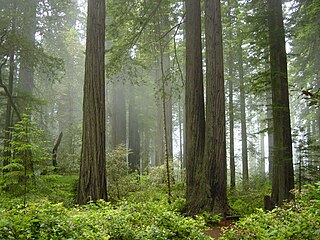
Poa nemoralis, the wood bluegrass, is a perennial plant in the Poaceae family. The late-growing grass is fairly nutritious for livestock, which feed on it in the autumn.

Nassella pulchra, basionym Stipa pulchra, is a species of grass known by the common names purple needlegrass and purple tussockgrass. It is native to the U.S. state of California, where it occurs throughout the coastal hills, valleys, and mountain ranges, as well as the Sacramento Valley and parts of the Sierra Nevada foothills, and Baja California.

Danthonia californica is a species of grass known by the common name California oatgrass. This plant is native to two separate regions of the Americas, western North America from California to Saskatchewan, and Chile.

Eragrostis cilianensis is a species of grass known by several common names, including stinkgrass, candy grass, and gray lovegrass.

Festuca idahoensis is a species of grass known by the common names Idaho fescue and blue bunchgrass. It is native to western North America, where it is widespread and common. It can be found in many ecosystems, from shady forests to open plains grasslands.

Festuca viridula is a species of grass known by several common names, including green fescue, greenleaf fescue, and mountain bunchgrass. It is native to western North America from British Columbia to Colorado, where it is most abundant in high-elevation forests and meadows.

Achnatherum pinetorum is a species of grass known by the common names pinewoods needlegrass and pine needlegrass. It is native to most of the western United States from California to Montana to New Mexico, where it grows in woodland and forest in rocky mountainous areas.
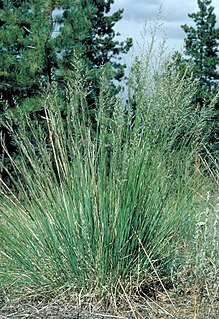
Muhlenbergia montana, with the common name mountain muhly, is a species of grass. It is native to North and Central America, where it is found throughout the Western United States, the Sierra Nevada, Mexico, and Guatemala.

Muhlenbergia porteri is a species of grass known by the common names bush muhly and Porter's muhly.

Muhlenbergia richardsonis, known by the common name mat muhly, is a species of grass. It is native to North America, where it can be found throughout much of Canada, Alaska, the western half of the contiguous United States through California, and in Baja California, Mexico.

Piptatherum miliaceum is a species of grass known by the common name smilograss. It is native to Eurasia but it can be found in many other parts of the world as an introduced species and a casual weed of disturbed areas. It is a clumping perennial grass producing sturdy, erect stems that can reach 1.5 meters tall. The inflorescence is a panicle of several whorls of branches that divide into secondary branches bearing clusters of spikelets.

Poa bolanderi is a species of grass known by the common name Bolander's bluegrass. It is native to western North America from British Columbia to Utah to California, where it is a resident of mountain habitat, particularly pine and fir forests. It is an annual grass growing in clumps up to 60 centimeters tall. The inflorescence occupies the top 10 to 15 centimeters of the stem. It is narrow in flower, with branches appressed, growing parallel to the stem. As the fruit develops the branches spread out, becoming perpendicular to the stem, nodding, or drooping. The branches have few, sparse spikelets.
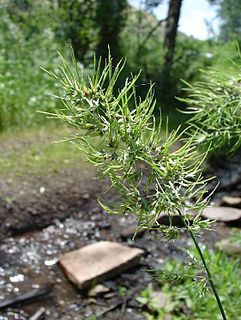
Poa bulbosa is a species of grass known by the common names bulbous bluegrass or bulbous meadow-grass. It is native to Eurasia and North Africa, but it is present practically worldwide as an introduced species. It is widespread in the United States and southern Canada. It was introduced to the eastern United States around 1906 and the western US in 1915 as a contaminant in shipments of alfalfa seed. It was intentionally planted on both the east and west coasts to control weeds and prevent erosion. Today it is a common grass across the continent and is a noxious weed in some areas. It is a sturdy, hardy, persistent, aggressive grass that easily outcompetes many other plants and becomes the dominant species in disturbed habitat types, such as overgrazed fields.

Poa leptocoma is a species of grass known by the common names marsh bluegrass and western bog bluegrass. It is native to western North America from Alaska to New Mexico, where it grows in subalpine and alpine climates and the Arctic. It is also known from the Kamchatka Peninsula.

Sporobolus cryptandrus is a species of grass known by the common name sand dropseed. It is native to North America, where it is widespread in southern Canada, most of the United States, and northern Mexico.
Sporobolus flexuosus is a species of grass known by the common name mesa dropseed. It is native to western North America, where it can be found in the deserts and woodlands of the Southwestern United States and Northern Mexico.

Ventenata dubia is a species of grass known by the common names North Africa grass and wiregrass. It is native to southern Europe, North Africa and the Middle East. It is becoming well known in North America, where it is an introduced species and a noxious weed of cultivated and disturbed habitat. It is problematic in the Pacific Northwest, where it was first identified in Washington in 1952 and Idaho in 1957. It was found in Utah in 1996. It probably spreads when it gets mixed in with grass seed and is transported and inadvertently planted.
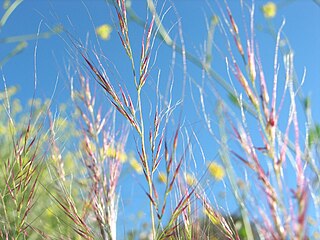
Vulpia microstachys is a species of grass known by the common names small fescue and small sixweeks grass. It is native to western North America from British Columbia to Colorado and New Mexico to Baja California, where it grows in many types of open habitat, including grasslands. It is dominant on some grasslands of California, and it was probably an abundant native grass before the habitat was altered by invasive non-native grasses. It occurs on serpentine soils with associates such as serpentine reedgrass. It is also known from parts of South America. It is an annual grass producing one stem or a clump of several stems growing up to 75 centimeters tall. The inflorescence has several open branches bearing clusters of purple-tinged spikelets. The spikelet has 1 to 6 flowers. The grass is usually cleistogamous, its flowers fertilizing themselves.
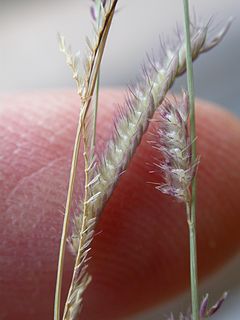
Bouteloua barbata is a species of grass known by the common name six-weeks grama. It is native to North America, where it occurs in the southwestern United States and south to Oaxaca in southern Mexico. It may occur in Montana. It is also present in Argentina.

Leucopoa kingii is a species of grass known by the common names spike fescue and King's fescue. It is native to the western United States from Oregon and California east to Nebraska and Kansas.



